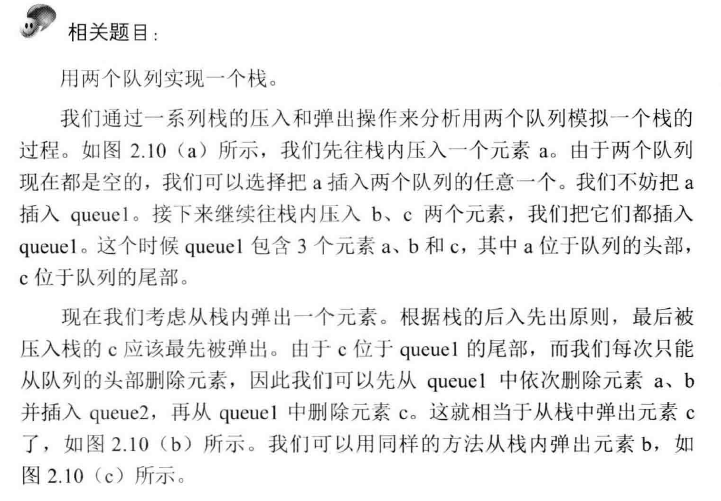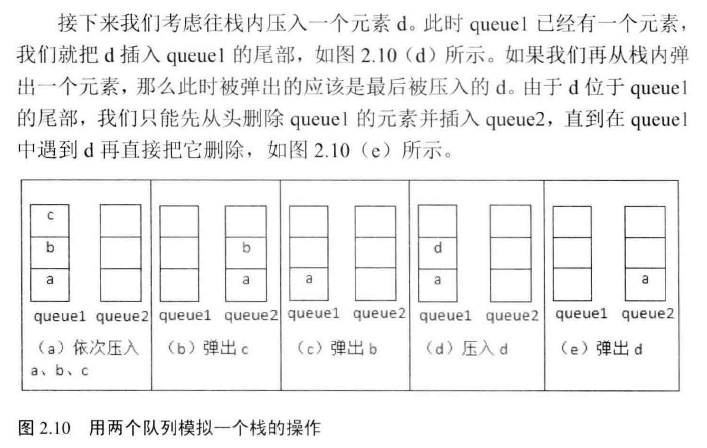// 面试题9:用两个栈实现队列 // 题目:用两个栈实现一个队列。队列的声明如下,请实现它的两个函数appendTail // 和deleteHead,分别完成在队列尾部插入结点和在队列头部删除结点的功能。 #pragma once #include <stack> #include <exception> using namespace std; template <typename T> class CQueue //模板, T为类型名 { public: CQueue(void); //构造函数 ~CQueue(void); //析构函数 // 在队列末尾添加一个结点 void appendTail(const T& node); // 删除队列的头结点 T deleteHead(); private: stack<T> stack1; stack<T> stack2; }; //CQueue<T>:: 为作用域 template <typename T> CQueue<T>::CQueue(void) { } template <typename T> CQueue<T>::~CQueue(void) { } template<typename T> void CQueue<T>::appendTail(const T& element) { //数据压入stack1 stack1.push(element); } template<typename T> T CQueue<T>::deleteHead() { //如果stack2为空,则从stack1中载入数据 if (stack2.size() <= 0) { while (stack1.size() > 0) { T& data = stack1.top(); stack1.pop(); stack2.push(data); } } //如果载入完还没数据, 则序列为空 if (stack2.size() == 0) throw new exception("Empty queue"); //弹出头部数据 T head = stack2.top(); stack2.pop(); return head; }

// 面试题9:用两个栈实现队列 // 题目:用两个栈实现一个队列。队列的声明如下,请实现它的两个函数appendTail // 和deleteHead,分别完成在队列尾部插入结点和在队列头部删除结点的功能。 #include "Queue.h" // ====================测试代码==================== void Test(char actual, char expected) { if (actual == expected) printf("Test passed. "); else printf("Test failed. "); } int main(int argc, char* argv[]) { CQueue<char> queue; queue.appendTail('a'); queue.appendTail('b'); queue.appendTail('c'); char head = queue.deleteHead(); Test(head, 'a'); head = queue.deleteHead(); Test(head, 'b'); queue.appendTail('d'); head = queue.deleteHead(); Test(head, 'c'); queue.appendTail('e'); head = queue.deleteHead(); Test(head, 'd'); head = queue.deleteHead(); Test(head, 'e'); return 0; }
分析:分析实际案例总结规律。
牛客网给出了数据类型,不知道函数直接这样写到类定义内是否正确。

class Solution { public: void push(int node) { stack1.push(node); } int pop() { if (stack2.size() <= 0) { while (stack1.size() > 0) { int data = stack1.top(); stack1.pop(); stack2.push(data); } } if (stack2.size() == 0) ; //throw new exception("Empty queue"); int head = stack2.top(); stack2.pop(); return head; } private: stack<int> stack1; stack<int> stack2; };
相关题目:思路几乎一致,
栈的弹出操作:队列1删除头节点并保存到队列2直到队列为空,最后的头节点为top值。
栈的写入操作:正常压入到当前非空队列尾部。


